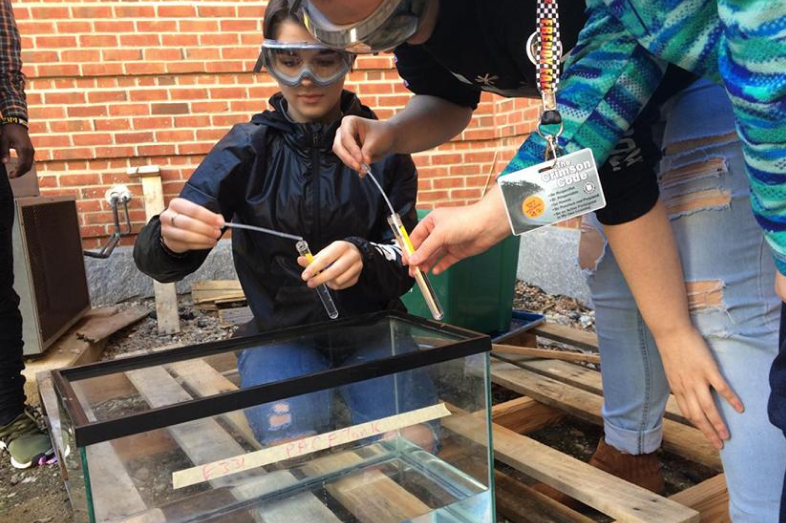

Reporter Laura Isensee of Houston Public Media was covering innovation in a Texas high school when she tried a fresh approach to help advance her reporting.
To tell the story, she trailblazed her own creative storytelling path. Isensee enlisted students for radio diaries to tell their personal stories about attending Houston’s Furr High School, which recently received a $10 million private grant to reinvent the high school experience. She pulled together a live event, too: a teacher “story slam” for educators in the Houston area to share their ideas and experiences to improve their schools and their students’ lives.
Isensee detailed this project at an EWA seminar last month on high school redesign. Isensee and two other reporters on the panel, Ben Herold of Education Week and Stacy Teicher Khadaroo of the Christian Science Monitor, have all taken deep dives into the school innovations popping up around the country. They presented recaps of their own reporting and practical tips to approach the changes happening in schools. They urged fellow journalists to bring a healthy skepticism along with an open mind.
Go Beyond the Buzzwords
In the same ways that schools are thinking outside the box, “as journalists, we can give ourselves permission to try new things and be creative and push some of the boundaries of how we tell these stories,” said Isensee, whose work was supported by an EWA Reporting Fellowship.
Herold, who has closely covered the national move toward personalized learning in classrooms, presented a list of five questions to prod schools and districts — including asking where the push is coming from and advice to break down buzzwords.
“When you say personalized learning, what the hell are you talking about?” he said, emphasizing that reporters should ask their sources to be more specific about their meaning when tossing around education jargon like personalized learning.
A couple other important questions Herold urged journalists to probe included: How will teaching and learning change? And where’s the evidence that the effort is working?
Khadaroo, also an EWA reporting fellow, discussed her story about the Manchester School of Technology High School — where standard grades aren’t awarded in most classes, and students advance at their own pace. It follows a trend throughout New Hampshire where schools are shifting to competency-based learning. Under this approach, students progress through the curriculum at their own pace and may advance to the next level or course when they demonstrate mastery, rather than meeting “seat time” requirements.
How Much Access Will a School Allow?
She found out about the school at a conference, but it wasn’t until she began asking for permission to visit the school that she found its real lucky charm: the high school was plentiful in its access. It helps if staff are open to questions and reporters poking around wherever they’d like, Khadaroo added.
“If you have the luxury of choosing a place to go profile, if you can kind of get a sense of how much access they’re going to give you, that really helps,” Khadaroo said.
Khadaroo had time to go back and process what she’d seen before her next school visit, which gave her a chance to think of new questions to get “deeper layers of what you’re looking for,” she said. She also spoke with school graduates, who gave candid assessments.
In Houston, Isensee talked about a model called “genius time” at the school she’d covered. Kids could pick anything they wanted to study during that time, like how to train a puppy, Isensee said.
Isensee said she worked with a school media teacher and a few students from the media team to produce radio diaries. It took some work on her end. Isensee was at the school once a week over a couple months to help students, float story ideas and check in with them, and ended up mixing audio for the students so the students could focus on storytelling. Since Isensee received financial support from the EWA reporting fellowship, she was also able to pay the students.
Just like many reporters in Houston, Isensee had to adapt after Hurricane Harvey hit the city in the summer of 2017. The school had a delayed start and the principal was suspended, which didn’t give Isensee a chance to report on her original plans for the end of her project.
Ask for Data to Gauge Impact
Approaching teachers for the “story slam” wasn’t difficult, she said. Getting people to come out to the event was a little more challenging, according to Isensee, since it was timed during a busy fall on a rainy day. Participating teachers discussed topics ranging from student voice to racism.
During the EWA panel, the journalists also discussed the importance of examining education data and other evidence to gauge the impact of school innovations.
Khadaroo said she batted around different data points, including 11th grade SAT scores, and ended up using test scores combined with dropout rates in her coverage, and a brief explanation in her story.
Herold also highlighted the importance of seeking evidence of claims made.. If a school boasts that its software program is research based, properly vet the studies first to be sure they stand up to scrutiny, he said. He added that reporters can turn to experts who can assess what school leaders and advocates are saying.
Herold’s tip: Make sure to ask district leaders how they plan to measure the success of the innovation.
“If they can’t answer those questions,” he said, “that might be a sign of a problem.”